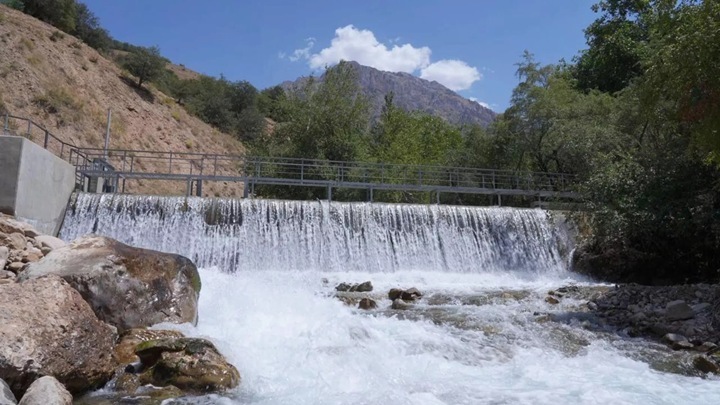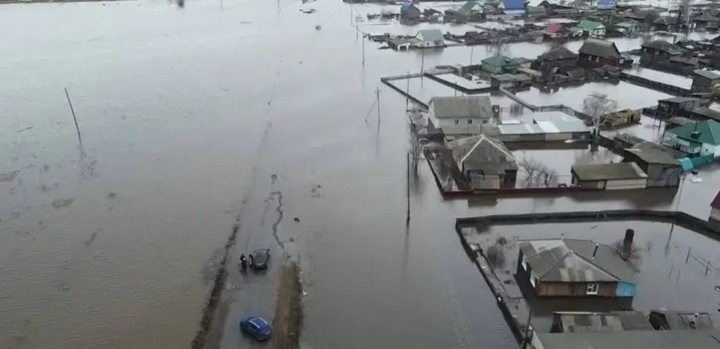Uzbekistan: the downside of small hydropower
The construction of mini-hydropower plants is positioned as a way to obtain “clean” energy from renewable sources, which helps reduce greenhouse gas emissions and climate change. However, it also comes with serious environmental and social risks that can exacerbate the problems associated with climate change, environmentalists in Uzbekistan believe.

Uzbekistan intends to make up for the shortage of electricity in the country by building large and small hydropower plants. In accordance with the decree of the President of the country Shavkat Mirziyoyev, the number of HPPs in Uzbekistan is planned to increase by 66.5% by 2030. In accordance with this decree, it is planned to build 21 large hydroelectric power plants with a total capacity of 740 MW in the country by 2026. It is planned to build mini-hydroelectric power stations (up to 5 MW) at 22 sites. Compact hydroelectric power stations (up to 500 kW) will be built to supply villages.
In January 2023, Uzbekhydroenergo identified 250 promising sites for the construction of mini-hydroelectric power stations based on public-private partnership. Only in 2023 it was planned to add another 197 MW to them due to the launch of 7 more facilities, as well as 10 micro-hydroelectric power stations. In addition, work has begun on the construction of 8 large and 50 small HPPs with a total capacity of 438 MW.
Uzbekhydroenergo JSC is the only structure in the country engaged in the development and implementation of programs for the development of the country’s hydropower potential. The Company is fully owned by the Ministry of Finance of the Republic of Uzbekistan, which exercises its shareholder rights on behalf of the state.
According to the information service of Uzbekhydroenergo JSC, 10.8% of energy in Uzbekistan is generated using hydroelectric power stations. In particular, small hydropower in the regions is a convenient and efficient solution for providing daily energy supply. Such stations are capable of providing electricity to individual districts and mahallas without connecting to a common network. The cost of the energy received is significantly lower compared to other sources, which makes hydropower a priority area of development.
In recent years, thanks to investments of $ 630 million, new hydroelectric power plants with a capacity of more than 400 megawatts have been built, their total capacity has reached 2.2 gigawatts.
There are currently 25 hydroelectric power plants with a total capacity of 1,330 megawatts operating in the Tashkent region alone, which is 60 percent of the country’s total hydropower capacity. Currently, four more hydropower plants with a total capacity of 340 megawatts and a cost of $ 880 million are under construction. By 2028, it is planned to implement 23 projects with a total capacity of about 2.4 thousand megawatts worth $ 4.8 billion.
A bet on small energy
However, despite this, there is still a shortage of electricity in the country. Therefore, the launch of small and mini HPPs in those regions where there are necessary conditions for this remains a priority of government plans.
Small hydropower (MGE) has become an important part of energy strategies around the world. Due to the fact that it adapts well to the needs of local residents and is suitable for remote rural areas with low energy consumption. In addition, it helps to reduce greenhouse gas emissions and increase energy independence.
In July 2023, a new mini-hydroelectric power station was launched in the Bostanlyk district of the Tashkent region. The power plant is located on one of the tributaries of the Pskov River, which flows into the Charvak reservoir. The power plant capacity was 200 kW. Annually it will generate up to 1.75 million kW/hour of energy. The same mini-hydroelectric power stations are being built today on the Ugam River.
There are three small HPPs in the list of investment projects for the construction of hydroelectric power stations on the Ugam River implemented by Uzbekhydroenergo JSC. The construction of HPP-1 will cost 4.2 million dollars, HPP-2 – 7.3 million dollars, HPP-3 – 6.9 million dollars. Construction began in 2024 and is likely to be completed in 2025. The total amount will be about $ 20 million.
With proper planning, IGE projects can also create conditions for empowering the local population, including groups typically facing various systemic constraints, in particular women and youth.
It is argued that hydropower is one of the cheapest, and therefore it is necessary to develop hydropower. It follows from the design data that the creation of the installed capacity of the three Ugam HPPs will cost about $ 3,800 per kilowatt of capacity. However, it is more expensive to create solar stations of the same total capacity.
How does the construction of a mini-hydroelectric power station affect the environment?
In the world, renewable energy is considered to be a key element in achieving both broader development goals (eradicating poverty and ensuring access to social services) and mitigating the climate crisis and preventing environmental degradation. Being the cheapest technology for generating electricity using renewable energy sources (RES), hydropower remains an integral part of international efforts to combat the climate crisis and ensure the transition to clean energy
Meanwhile, environmentalists from Uzbekistan note a number of problems associated with the construction of mini-hydroelectric power stations, which can cause serious damage to the ecosystems of mountain rivers and not bring the expected results.
Evgeny Simonov, a leading expert of the Rivers Without Borders International Public Foundation, says that the construction of a hydroelectric power station on the Pskov River violates the nature protection territory, since it is located on the territory of the Ugamo-Chatkal Nature Park.
“The length of the Pskov River is about 70 km. According to the latest information, glaciers, where the mountain rivers of Uzbekistan originate, are melting very quickly due to climate change. And the construction of mini-hydroelectric power stations on such mountain rivers is fraught with the fact that at some point the river may dry up. Also, energy production depends on the flow of the volume of water and the height of its fall. And with a decrease in the volume of water due to climate change, it will generate less electricity, which was planned earlier,” says Simonov.
The damage caused to nature during the construction of small hydropower plants will be much greater than the acquired megawatts, he believes.
A zoologist, an employee of the Institute of Zoology of the Academy of Sciences of Uzbekistan, Timur Abduraupov, agrees with him, who also notes that no one calculates the damage caused to nature during the construction of a mini-hydroelectric power station.
“The construction of power plants causes enormous damage to nature, as habitats are lost and there are losses of the animals themselves. Unfortunately, during the construction of such structures, no one does further analysis of damage to nature. The law “On Hunting and Hunting Economy”, Resolution No. 290 of the Cabinet of Ministers of the Republic of Uzbekistan specifies the price of each plant, animal, insect,” he says.
According to Abduraupov, the Ministry of Ecology should deal with this.
“It has to calculate the damage. And organizations that build mini-gas stations must pay the state for the damage caused to nature. That is, when planning the construction of any structure, the Ministry of Ecology should give a specific answer, having previously conducted an expert examination, whether endemic species live or grow in these territories, what damage these species will cause to the construction,” he said.
Bakhtiyor Sheraliev, an ichthyologist biologist, says that if we take into account that most mini-hydroelectric power plants are built on the basis of mountain rivers, it is necessary to pay attention to how much local hydrobionts are taken into account [organisms adapted to living in an aquatic environment – approx. editor].
“Because the composition of the ichthyofauna of most of our mountain rivers is unique, and they are endemic species of the region. For example, you can find such rare and rare species of fish as Triplophysa daryoae in the Fergana Valley, Triplophysaferganaensis in the Shokhimardonsoi, Iskandaria kuschakewitschi in the Chodaksoi, Triplophysa elegans in the Dukentsai in the Tashkent region, Cottus spinulosus in the Ugam River,” said the ichthyologist.
In his opinion, small hydroelectric power plants installed in the beds of these rivers and streams can impede the migration of fish in the basin and affect the reproduction of species.
Before the construction of mini-HPPs, it is necessary to conduct an environmental assessment in order to scientifically assess their impact on local biological species, Sheraliev believes
In addition, mini-hydroelectric power plants can influence the flow of water, changing its mode, speed, level, temperature and other characteristics.
“Mini-hydroelectric power plants take part of the water from the river for the operation of turbines, which leads to a redistribution of runoff. Downstream from the point of water intake, the flow of the river can decrease significantly, especially during periods of low water. The impact of mini-hydroelectric power plants on runoff may vary depending on the season. During periods of floods or high runoff, water withdrawal can be minimal, while during periods of autumn, withdrawal can significantly reduce the flow,” he says.
In front of the water intake structures, the flow of the river slows down due to water back-up. This leads to siltation and a change in the structure of the bottom. In some parts of the channel after the hydroelectric power plant, the flow may accelerate due to the concentrated flow of water. Turbulence can occur in places where water is discharged due to hydroelectric power plants, which can affect coastal erosion and water mixing.
Ensuring universal access to electricity remains one of the key tasks in the world, both from the point of view of economics, environmental protection and social development. More than 700 million people, i.e. approximately 9.5 percent of the world’s population, mostly living in rural areas, still do not have access to electricity.
Therefore, the construction of mini-hydropower plants is one of the ways to provide energy and reduce greenhouse gas emissions. But it also comes with serious environmental and social risks that can exacerbate the problems associated with climate change.
In order to minimize these risks and ensure sustainable development, it is necessary to conduct a thorough impact assessment, introduce modern technologies and ensure compliance with environmental standards, Uzbek environmentalists say.
Nargis Kosimova (CABAR.asia )


